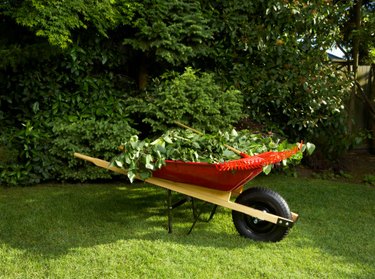
Grubs, or grub worms, are the immature larvae of beetles and chafers. Grub worm damage is most commonly seen in the turfgrasses used for lawns. However, some species of grubs also feed on the roots of trees and other plants. Grubs can also cause damage because they attract predators, like skunks and raccoons, that will not hesitate to tear up a lawn in search of grubs to eat.
Identifying Grubs in Soil
Video of the Day
Beetles and chafers lay eggs in soil at various points during summer. The eggs take one or two weeks to hatch. The larvae that result are referred to as grubs. Grubs can be easily identified by their shape because they curl up into a "C" shape. They can also be identified by their coloring: They are creamy white with a brownish-red head. They vary in size but may be up to an inch long. It usually takes a year for them to reach maturity.
Video of the Day
Grubs cause the most damage during summer and fall in the weeks after they hatch. As temperatures drop in the fall, they burrow deep into the soil, where they spend the winter in a dormant state. In the spring, they make their way closer to the surface to feed again before eventually emerging as adult beetles.
What Do Grubs Eat?
Many types of grub worms, including those of the European chafer and the Japanese beetle, feed on the roots of grasses. Their feeding can cause severe damage to a turfgrass lawn. Some grubs also feed on the roots of flowering plants and crop plants, like strawberries, potatoes and corn.
While most types of grubs feed mostly on the roots of grasses exclusively, the larvae of some species of beetles can cause severe damage to tree roots. These include the larvae of the tenlined June beetle, which occurs in the Western United States deciduous fruit trees, such as apple and almond trees among others. In other parts of the country, like Wisconsin and Michigan, June beetle grubs and the grubs of the European chafer are a pest of Christmas tree species, including spruce, fir and pine. Young trees are most susceptible.
Controlling Lawn Grubs
There are both chemical and biological control methods available for grub control. Insecticides that contain the ingredients imidacloprid, chlorantraniliprole or clothianidin are effective against white grubs; however, they work best on young larvae. Therefore, it is best to apply them just as the eggs are beginning to hatch. Insecticides can be harmful to beneficial insects, like bees, so remove any flowers from your lawn before applying them in order to keep away pollinators.
Alternatively, you can treat your lawn with parasitic nematodes, which are small roundworms that kill grubs. Nematodes in the genus Heterorhabditis work best on white grubs. It is important that soil temperatures be at or above 50 degrees Fahrenheit in order for nematodes to effectively parasitize grubs.
There are also cultural practices that can help limit grub worm damage. One strategy is to have your lawn grow on the taller side, which will in turn lead to a stronger, deeper root system that can withstand the feeding of grub worms. Lawns that are properly watered are also more resistant to grub worm damage.
- Colorado State University Extension: Billbugs and White Grubs: Control in Home Lawns
- Washington State University: Tenlined June Beetle
- Michigan State University Extension: Managing Grubs in Christmas Trees
- Wisconsin Horticulture Division of Extension: White Grubs on Christmas Trees
- University of New Hampshire: White Grubs [Fact Sheet]